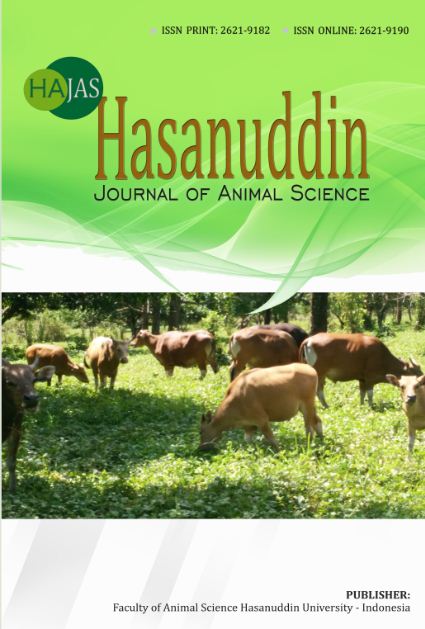The Effects Rubber Leaf (Hevea brasiliensis) Flour Addition in Non-AGP Commercial Rations on Blood Cholesterol Levels of Broiler
Abstract
The research aimed to analyze the effects of adding rubber leaf (Hevea brasiliensis) flour in non-AGP commercial rations on the blood cholesterol levels of broiler chickens. The materials used were 200 heads of Day Old Chick (DOC) unsex from MB-202 strain, non-AGP commercial ration containing 22% protein, and rubber leaf flour with a tannin content of 2.5% DM basis. The experiment was designed using a completely randomized design (CRD) with four treatments and five repetitions, and each repetition unit consists of 10 DOCs. The treatment was the addition of rubber leaf flour by 0% (P0), 5% (P1), 7,5% (P2), and 10% (P3) in 100% of the commercial ration given. Broiler chickens were raised in colony battery cages for five weeks of the trial period. The observed variables were cholesterol, triglyceride, HDL, and LDL plasma levels. Data were analyzed using analysis of variance and Duncan's multiple range test. The results showed that the estimated tannin compounds in rubber leaf powder consumed were 0.11%-0.22% and that the feeding treatment significantly decreased (P<0.05) blood cholesterol and triglyceride levels and significantly increased (P<0.05) blood HDL levels. Still, it had no significant effect on the LDL levels of broiler chickens. Based on the study's results, it can be concluded that adding 7.5%-10% rubber leaf flour to commercial rations can be used as a feed additive for reducing blood cholesterol levels in broiler chickens.
Keywords: Rubber Leaf Flour, Broiler Chicken, Cholesterol, Triglycerides, HDL, LDL
Downloads
Published
Issue
Section
License

This work is licensed under a Creative Commons Attribution-NonCommercial 4.0 International License.











